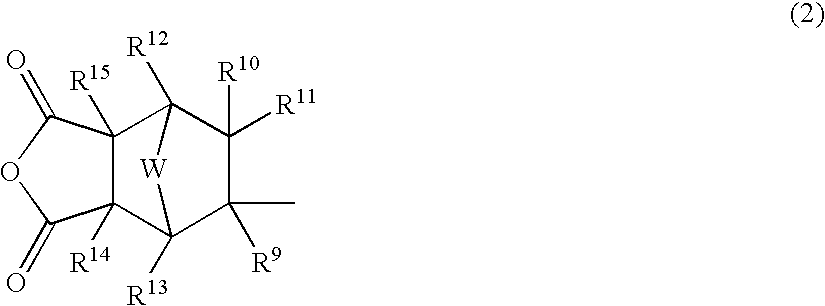Underfill composition and packaged solid state device
a technology of composition and solid state device, which is applied in the direction of transportation and packaging, chemical instruments and processes, synthetic resin layered products, etc., can solve the problems of significant mechanical stress experienced by solder bumps in the construction of flip chips, mechanical and electrical failure of electronic devices, and many encapsulant compounds utilized in such underfill materials suffer from the inability to fill small gaps (50-100 m) between the chip and the substra
- Summary
- Abstract
- Description
- Claims
- Application Information
AI Technical Summary
Benefits of technology
Problems solved by technology
Method used
Image
Examples
example 1
[0072]Preparation of difunctional siloxane anhydride. A 500 milliliter (ml) flask equipped with mechanical stirrer, thermometer, condenser, addition funnel and nitrogen inlet was charged with 127 grams (0.77 mols) of 5-norbornene-2,3-dicarboxylic anhydride, 150 grams of toluene and 20 ppm of platinum as Karstedt's catalyst (i.e., a complex of Pt0 with divinyltetramethyldisiloxane as described in U.S. Pat. No. 3,775,442). The solution was heated to 80° C. at which point 84.3 grams (0.4 mols) of 1,1,3,3,5,5-hexamethyltrisiloxane was added drop-wise to the reaction mixture. A mild exotherm took place and the temperature was raised to 100° C. The addition of silicone hydride was completed in 1 hour. The reaction mixture was stirred at 80° C. for one additional hour. Infrared (IR) analysis was conducted using an Avatar 370 FT-IR (from Thermo Electron Corporation); the results showed 75% conversion of Si—H groups. An additional 20 ppm of the platinum catalyst was added and the reaction mi...
example 2
[0074]Preparation of functionalized colloidal silica pre-dispersions. A functionalized colloidal silica pre-dispersion (pre-dispersion 1) was prepared using the following procedure. 465 grams of aqueous colloidal silica (Nalco 1034A, Nalco Chemical Company) containing about 34 weight % of 20 nm particles of silica, was mixed with 800 grams of isopropanol (Aldrich) and 56.5 grams of phenyltrimethoxy silane (Aldrich) by stirring. The mixture was heated to 60-70° C. for 2 hours to give a clear suspension. The resulting pre-dispersion 1 was cooled to room temperature and stored in a glass bottle.
[0075]A pre-dispersion 2 of functionalized colloidal silica was prepared using the following procedure. 465 grams of aqueous colloidal silica (Nalco 1034A, Nalco Chemical Company) containing about 34 weight % of 20 nm particles of silica, was mixed with 800 grams of isopropanol and 4.0 grams of phenyltrimethoxy silane by stirring. The mixture was heated to 60-70° C. for 2 hours to give a clear s...
example 3
[0076]Preparation of resin 1 containing stabilized functionalized colloidal silica. A 1000 ml flask was charged with 300 grams of the colloidal silica pre-dispersion 1 from Example 2, 150 grams of 1-methoxy-2-propanol (Aldrich) as solvent and 0.5 grams of crosslinked polyvinylpyridine. The mixture was stirred at 70° C. After 1 hour the suspension was blended with 4 grams Celite® 545 (a commercially available diatomaceous earth filtering aid), cooled down to room temperature and filtered. The resulting dispersion of functionalized colloidal silica was blended with 40 grams of 3,4-epoxycyclohexylmethyl-3,4-epoxycyclohexane carboxylate (UVR6105 from Dow Chemical Company) and vacuum stripped at 75° C. at 1 Torr to constant weight to yield 87.9 grams of a viscous liquid resin (Resin 1).
PUM
| Property | Measurement | Unit |
|---|---|---|
| particle size | aaaaa | aaaaa |
| particle size | aaaaa | aaaaa |
| viscosity | aaaaa | aaaaa |
Abstract
Description
Claims
Application Information
 Login to View More
Login to View More - R&D
- Intellectual Property
- Life Sciences
- Materials
- Tech Scout
- Unparalleled Data Quality
- Higher Quality Content
- 60% Fewer Hallucinations
Browse by: Latest US Patents, China's latest patents, Technical Efficacy Thesaurus, Application Domain, Technology Topic, Popular Technical Reports.
© 2025 PatSnap. All rights reserved.Legal|Privacy policy|Modern Slavery Act Transparency Statement|Sitemap|About US| Contact US: help@patsnap.com



